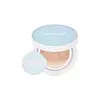Cher Skincare BB Water Resistance Physical Sunscreen SPF 50 Versus Dr. Pong Acne Ace Longwear Cushion
What's inside
What's inside
 Key Ingredients
Key Ingredients

 Benefits
Benefits

 Concerns
Concerns

No concerns
 Ingredients Side-by-side
Ingredients Side-by-side

Cyclopentasiloxane
EmollientDimethicone Crosspolymer
Emulsion StabilisingDimethicone
EmollientTitanium Dioxide
Cosmetic ColorantZinc Oxide
Cosmetic ColorantGlycerin
HumectantSaccharum Officinarum Extract
MoisturisingSodium Polyacrylate
AbsorbentPolyisobutene
Polymethylsilsesquioxane
1,2-Hexanediol
Skin ConditioningMethylpropanediol
SolventEthylhexylglycerin
Skin ConditioningHydroxyacetophenone
AntioxidantCI 77492
Cosmetic ColorantCI 77491
Cosmetic ColorantCI 77499
Cosmetic ColorantWater
Skin ConditioningDiphenylsiloxy Phenyl Trimethicone
Skin ConditioningCyclopentasiloxane
EmollientEthylhexyl Methoxycinnamate
UV AbsorberPhenyl Trimethicone
Skin ConditioningButylene Glycol
HumectantGlycerin
HumectantCetyl PEG/PPG-10/1 Dimethicone
EmulsifyingLauryl PEG-10 Tris(Trimethylsiloxy)Silylethyl Dimethicone
EmulsifyingTrimethylsiloxysilicate
EmollientPolymethylsilsesquioxane
Sodium Chloride
MaskingDisteardimonium Hectorite
StabilisingPhenoxyethanol
PreservativeSilica
AbrasiveTriethoxycaprylylsilane
Aluminum Hydroxide
EmollientChlorphenesin
AntimicrobialQuartz
AbrasivePolyurethane-40
Bis-PEG-15 Dimethicone/Ipdi Copolymer
PPG-70 Glyceryl Ether
EmollientSalicylic Acid
Masking1,2-Hexanediol
Skin ConditioningBiosaccharide Gum-4
Skin ConditioningAnthemis Nobilis Flower Extract
MaskingHouttuynia Cordata Extract
Skin ConditioningCentella Asiatica Leaf Extract
Skin ConditioningSodium Hyaluronate
HumectantHydrolyzed Hyaluronic Acid
HumectantSodium Acetylated Hyaluronate
HumectantCI 77891
Cosmetic ColorantCI 77492
Cosmetic ColorantCI 77491
Cosmetic ColorantCI 77499
Cosmetic ColorantWater, Diphenylsiloxy Phenyl Trimethicone, Cyclopentasiloxane, Ethylhexyl Methoxycinnamate, Phenyl Trimethicone, Butylene Glycol, Glycerin, Cetyl PEG/PPG-10/1 Dimethicone, Lauryl PEG-10 Tris(Trimethylsiloxy)Silylethyl Dimethicone, Trimethylsiloxysilicate, Polymethylsilsesquioxane, Sodium Chloride, Disteardimonium Hectorite, Phenoxyethanol, Silica, Triethoxycaprylylsilane, Aluminum Hydroxide, Chlorphenesin, Quartz, Polyurethane-40, Bis-PEG-15 Dimethicone/Ipdi Copolymer, PPG-70 Glyceryl Ether, Salicylic Acid, 1,2-Hexanediol, Biosaccharide Gum-4, Anthemis Nobilis Flower Extract, Houttuynia Cordata Extract, Centella Asiatica Leaf Extract, Sodium Hyaluronate, Hydrolyzed Hyaluronic Acid, Sodium Acetylated Hyaluronate, CI 77891, CI 77492, CI 77491, CI 77499
Ingredients Explained
These ingredients are found in both products.
Ingredients higher up in an ingredient list are typically present in a larger amount.
1,2-Hexanediol is a synthetic liquid and another multi-functional powerhouse.
It is a:
- Humectant, drawing moisture into the skin
- Emollient, helping to soften skin
- Solvent, dispersing and stabilizing formulas
- Preservative booster, enhancing the antimicrobial activity of other preservatives
Ci 77491 is also hydrated iron III oxide. It's sole purpose is to give a red/pink hue to products.
Iron III oxides are classified as inorganic chemicals for coloring.
Synthetically created Ci 77491 is considered safer than those naturally found. This is because the synthetically created version may contain less impurities. Iron oxides are generally non-toxic and non-allergenic.
Learn more about CI 77491Ci 77492 is also hydrated iron III oxide. It's sole purpose is to give a yellow hue to products.
Iron III oxides are classified as inorganic chemicals for coloring.
Synthetically created Ci 77492 is considered safer than those naturally found. This is because the synthetically created version may contain less impurities. Iron oxides are generally non-toxic and non-allergenic.
Learn more about CI 77492Ci 77499 is also hydrated iron III oxide. It is created from mixing red and black iron oxides. This helps give shades of darkness to a product.
Iron III oxides are classified as inorganic chemicals for coloring.
Cyclopentasiloxane, or D5, is a silicone used to improve texture of products and trap moisture.
D5 is considered lightweight and volatile. Volatile means it evaporates quickly after application. Once evaporated, D5 leaves a thin barrier that helps keep skin hydrated.
It is also an emollient. Emollients help soften the skin and prevent water loss. Silicones create a silky texture in products. D5 helps other ingredients become more spreadable.
Studies show D5 is safe to use in skincare products. We recommend speaking with a skincare professional if you have concerns.
Learn more about CyclopentasiloxaneGlycerin is already naturally found in your skin. It helps moisturize and protect your skin.
A study from 2016 found glycerin to be more effective as a humectant than AHAs and hyaluronic acid.
As a humectant, it helps the skin stay hydrated by pulling moisture to your skin. The low molecular weight of glycerin allows it to pull moisture into the deeper layers of your skin.
Hydrated skin improves your skin barrier; Your skin barrier helps protect against irritants and bacteria.
Glycerin has also been found to have antimicrobial and antiviral properties. Due to these properties, glycerin is often used in wound and burn treatments.
In cosmetics, glycerin is usually derived from plants such as soybean or palm. However, it can also be sourced from animals, such as tallow or animal fat.
This ingredient is organic, colorless, odorless, and non-toxic.
Glycerin is the name for this ingredient in American English. British English uses Glycerol/Glycerine.
Learn more about GlycerinPolymethylsilsesquioxane is a silicone used as a film forming agent.
When applied to the skin, this ingredient creates an invisible film on the surface. This film still allows oxygen to pass through, but prevents moisture from escaping. This can help condition and hydrate the skin. It also leaves a silky feel when applied.
Polymethylsilsesquioxane has not been shown to clog pores. It has been deemed safe to use up to 55%, but most cosmetics use much less.
If you have concerns about using this ingredient, we recommend speaking with a professional.
Learn more about Polymethylsilsesquioxane